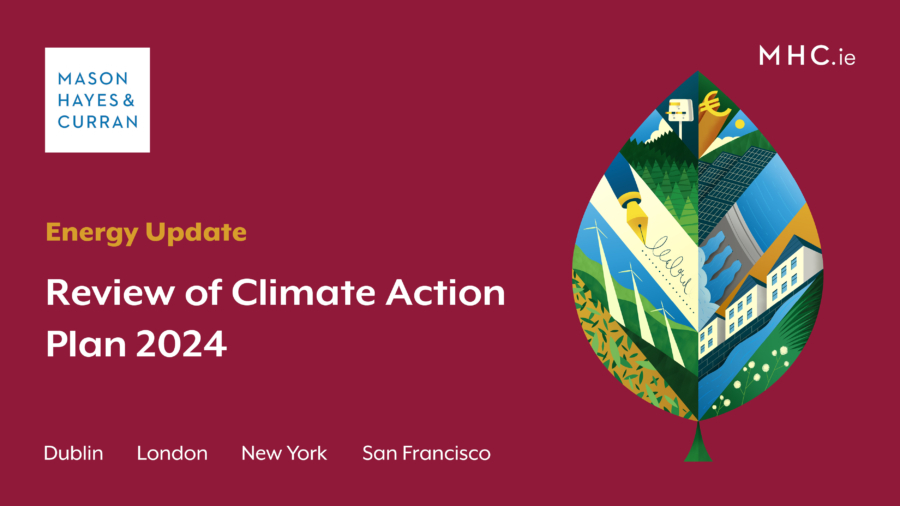Review of Climate Action Plan 2024

The proposed Climate Action Plan 2024 was recently published by the Irish Government. While the Plan is due to undergo environmental assessment and public consultation early this year before being finalised, our Energy team looks at its targets and policies for the renewable energy sector.
The Climate Action Plan (CAP) is the Irish Government’s roadmap to delivering on its climate targets. It was first published in 2019 and was later updated in 2021 and 2023. Under the Paris Agreement and the European Green Deal, Ireland is committed to reducing greenhouse gas emissions (GHG) by 51% against 2018 levels by 2030 and to becoming carbon neutral by 2050. The aim of these commitments is to try collectively with other nations to limit global warming to 1.5°C. While CAP 2024 is yet to undergo environmental assessment and public consultation, we review its targets and policies for renewable energy.
Where we are now
The Environmental Protection Agency (EPA) of Ireland has reported that electricity generation accounted for 14.4% of Ireland’s total GHG emissions in 2022. During the whole of 2022, GHG emissions from electricity generation fell by 1.9% due to an increase in renewable electricity generation coupled with a reduction in the use of fossil fuels. However, to stay within the first carbon budget of 40 MtCO2eq assigned to the electricity sector for the period 2021-2025, the electricity sector requires a decarbonisation rate of 17.3% per annum in the period 2023-2025. For context, the average decarbonisation rate between 2018 and 2022 was 1.4% per annum.
The EPA’s projections indicate that if all the measures in CAP 2023 and the ‘yet unallocated emissions savings’ (savings that are expected to be achieved through future advancements in technology and other areas) are accounted for, the projected total emissions reduction for all sectors by 2030 will be 42%. This represents a 9 percentage point shortfall of the EU’s 2030 reduction target of 51% against 2018 levels. This is a significant residual gap that CAP 2024 aims to close by setting out further policies, measures, and actions in addition to those set out in earlier editions of the CAP. These additional measures are outlined below. A radical reduction of emissions in the electricity sector, through the adoption of a renewables-led system, remains at the core of CAP 2024.
Where we are going
The key targets from CAP 2023 with regard to renewable energy are retained in CAP 2024. They are:
National Target |
2025 |
2030 |
Renewable Energy Sector Share |
50% |
80% |
Onshore Wind |
6GW |
9GW |
Solar |
Up to 5GW |
8GW |
Offshore Wind |
- |
At least 5GW |
Flexible Gas Plant |
- |
At least 2GW |
Demand Side Flexibility |
15-20% |
20-30% |
New policies, measures and actions
Some of the new policies, measures and actions included in CAP 2024 to achieve these targets include:
Accelerate renewable energy generation
To reach 80% of electricity demand from renewable sources by 2030, the Government is aiming to accelerate the delivery of utility-scale onshore wind, offshore wind, and solar projects through a competitive framework. This will involve updating existing policies and guidelines to streamline the consenting process. It is intended that the following documents which were intended to be published under CAP 2023 save for the newly proposed Solar Energy Development Guidelines will be revised, updated, and published during the lifetime of CAP 2024:
- Update the revision of the National Planning Framework,
- Publish a new Electricity Generation Grid Connection Policy,
- Publish the Draft Renewable Electricity Spatial Policy Framework White Paper,
- Publish the revised methodology for Local Authorities Renewable Energy Strategies
- Publish the Draft Revised Wind Energy Development Guidelines
- Commence drafting Solar Energy Development Guidelines
- Adopt the Electricity Storage Policy Framework
- Following finalisation of a Regional Roadmap, regional assemblies will publish and implement Regional Renewable Electricity Strategies (RRES). This will enable a unified methodology for national and regional spatial and capacity targets, and identify areas suitable for renewable electricity deployment at regional and county levels that can inform the statutory planning process, and
- Following adoption of the RRES, local authorities will include a statement within their next Local Authority Climate Action Plans which identifies the methods or processes that will be used to implement the required policy supports to achieve renewable electricity targets.
2030+ Offshore Renewable Energy Roadmap
The publication of a ‘2030+ Offshore Renewable Energy Roadmap’ is planned for Q2 2024. The purpose of the roadmap will be to determine pathways to deploy offshore/ocean technology. This will involve producing technology scenarios, conducting stakeholder consultation, and identifying enabling policies and the appropriate regulatory framework.
Offshore Renewable Energy Innovation Park
By Q4 2024, the Government aims to finalise and publish a ‘Designated Maritime Area Plan’ for the development of an offshore renewable energy innovation park. This will involve exploring options for grid connection, options for routes to access and operating model, and publishing a report on the critical path deliverables achieved to facilitate the ‘Routes to Access Phase’ of the proposed innovation park.
Hydrogen ambition
The Government intends to address unallocated GHG emissions savings by increasing hydrogen ambition to achieve hydrogen uptake in line with the ambition outlined in the National Hydrogen Strategy. This will be primarily through scaling electrolyser capacity. The Government is also aiming to support green hydrogen production through surplus generation from 2GW of offshore wind energy. This is to provide greater certainty for investors and to create the production scales needed to enable greater infrastructure deployment.
Low carbon flexibility opportunities
To further address unallocated GHG emissions savings, the Government intends to build out low carbon flexibility opportunities such as long duration energy storage. The deployment of carbon capture, utilisation, and storage (CCUS) technology was not integrated in previous editions of the CAP. By incorporating CCUS into CAP 2024, it is hoped to address a portion of unallocated savings in Ireland between 2026-2030 with regard to electricity generation. It is expected that this technology will play a significant role in future decarbonisation of the energy sector. To achieve this, the Government intends to incentivise and enable large energy users to participate in flexible demand initiatives. This approach is designed to enable low / zero carbon demand growth, and to create a route to market for medium and long duration storage facilities which can provide flexible demand.
Community Benefit Fund
All new or repowered renewable electricity generation projects will be required to implement a Community Benefit Fund equivalent to the RESS requirements of €2/MWh. The establishment of community benefit funds for renewable energy projects is considered to improve public acceptance of projects at a local level. This is fundamental to increasing the level of consents being granted for renewable energy projects.
Comment
Delivery and integration of onshore and offshore wind and solar PV continues to be recognised in the CAP as the best-performing mitigation measure to deliver the required emissions abatement at scale and at speed to achieve Ireland’s GHG emission reduction targets. This is because no other supply-side measure comes close to the emissions abatement achieved by the early and rapid deployment of wind and solar capacity. It is estimated that an eight-times increase of renewable energy deployment to 2.3GW annually is needed between 2024 and 2030, together with the delivery of at least 2GW of new flexible gas-fired generation.
CAP 2024 seeks to achieve these targets by trying to build on measures in earlier editions of the CAP, such as the expected enactment of the Planning and Development Bill 2023, aimed at streamlining the consenting process.
CAP 2024 will be subject to public consultation and environmental assessment. It is possible therefore that there will be further changes to the plan.
For more information contact a member of our Energy team.
The content of this article is provided for information purposes only and does not constitute legal or other advice.
Share this:






